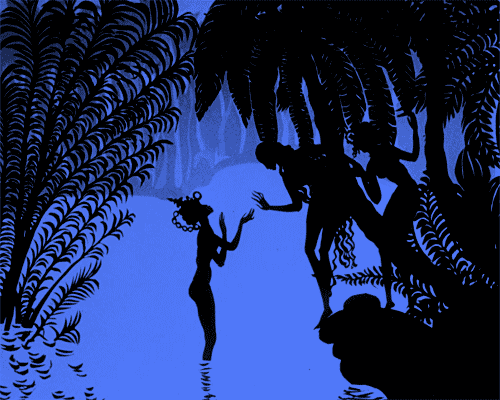Lotte Reiniger

Reiniger had a natural aptitude for cutting out figures from a very early age and enjoyed performing puppetry as child, as it was seeing characters in motion that really thrilled her. As a young woman, she was inspired by German expressionist filmmaker Paul Weneger and contributed at the age of 19 to Weneger's film 'The Pied Piper of Hamelin' (1918).
Lotte Reiniger (1899-1981) was a German animator best known for her pioneering use of cut-outs to create complete animated films.
Influenced by traditional ancient techniques from Chinese shadow puppetry, Reiniger immortalised the use of these simple silhouettes for the emerging modern art of animation.

'The Pied Piper of Hamelin' (1918) Intertitle by Reiniger, directed by Weneger.
Reiniger continued to develop her signature style of silhouette animation in short films, joining experimental animation studio, the Berliner Institut für Kulturforschung. She worked on several shorts at this time, among them The Star of Bethlehem, Sleeping Beauty and Cinderella. Fairy tales were a constant theme in her work, and her style of imagery perfectly fit the whimsy and oddness of those stories.

This diagram illustrates the amount of hinges on Reiniger's cardboard/lead marionettes. Despite the apparent simplicity of the flat silhouettes, the amount of joints on the figures manage to convey a sophisticated elegance and subtlety, due to Reiniger's deftness of touch.

The figures were place on a 'trick table' lit from underneath, on a glass plate with a paper layer. Most of the figures were 9 inches high. For further away figures in long shot they would be 5 inches high and for close-ups a larger, more detailed cut-out would be needed.
'The Adventures of Prince Achmed'

'The Adventures of Prince Achmed' (1926), written and directed by Lotte Reiniger, is the oldest surviving animated feature film. It is for this feature that Reiniger's place in film history is assured.
I love the intricate designs in the film. There is so much rich texture for a medium that could feel stilted. As a product of the silent cinema age, the silhouettes have to convey much character in body language, and it's all the better for not relying on dialogue. Reiniger was resistant to the change into talkies and felt that her figures were not intended to speak.
It is amazing the level of depth that could be created with very basic tools. Translucency of paper shows a receding landscape. Colour has a power all of its own and also suggests a change of location. I can't help feel like I want to attempt a similar process after watching the film, that's often the joy of watching something that really feels handmade.





